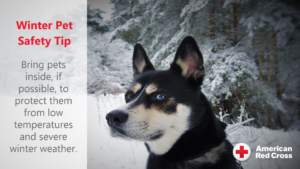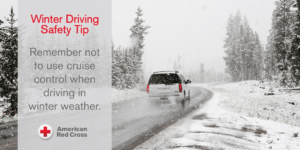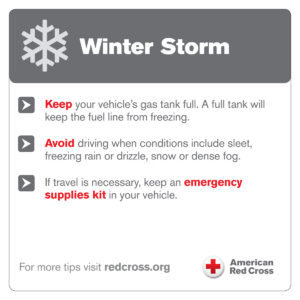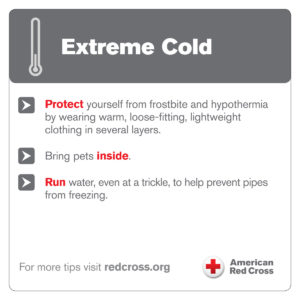As winter hits full stride across the country, the Red Cross offers these winter storm tips to help you safely weather the storms.
(And if you don’t have an emergency kit together, start with that!)
Winter weather tips to prep your home:
- If there’s a power outage, go to a designated public shelter to stay warm.

- Keep your thermostat at the same setting day and night.
- Bring pets indoors. If that’s not possible, make sure they have enough shelter to keep them warm and that they can get to unfrozen water.
- Run water, even at a trickle, to help stop pipes from freezing. Keep garage doors closed if there are water lines in the garage
- Before taking on tasks such as shoveling snow, consider your physical condition.
- Insulate your home by installing storm windows or covering windows with plastic from the inside to keep cold air out.
- Maintain heating equipment and chimneys by having them cleaned and inspected every year.
- If you will be going away during cold weather, leave the heat on in your home, set to a temperature no lower than 55° F.
If you’re headed outside in the winter:
- Know the signs of hypothermia – confusion, dizziness, exhaustion and severe shivering. If someone has these symptoms, they should get immediate medical attention.
- Watch for symptoms of frostbite including numbness, flushed gray, white, blue or yellow skin discoloration, numbness or waxy feeling skin.
- Dressing in several layers of lightweight clothing keeps someone warmer than a single heavy coat.
- Mittens provide more warmth to the hands than gloves. Wear a hat, preferably one that covers the ears.
- Wear waterproof, insulated boots to keep feet warm and dry and to maintain one’s footing in ice and snow.
Tips to stay safe in the car this winter:
- The safest thing to do during a winter storm is stay off the roads if possible.
- Winterize your vehicle and keep the gas tank full. A full tank will keep the fuel line from freezing.
- Clean the lights and windows to help you see.
- If you can, avoid driving in sleet, freezing rain, snow or dense fog. If you have to drive, make sure everyone has their seat belts on and give your full attention to the road. Avoid distractions such as cell phones.
- If you have to travel, keep a disaster supplies kit in the car.
- Don’t follow other vehicles too closely. Sudden stops are difficult on snowy roadways.
- Don’t use cruise control when driving in winter weather.
- Don’t pass the snow plow truck.
- Find out what the weather is where you are traveling. Before you leave, let someone know where you are going, the route you plan to take, and when you expect to get there. If your car gets stuck, help can be sent along your predetermined route.
If you’re stuck in the car:
- If someone does get stuck, stay with the car. Do not try to walk to safety. (Unless, of course, you can see a heated building that you can safely get to)
- Tie a brightly colored cloth (preferably red) to the antenna for rescuers to see.
- Start the car and use the heater for about 10 minutes every hour. Keep the exhaust pipe clear so fumes won’t back up in the car.
- Leave the overhead light on when the engine is running to help rescuers see the vehicle.
- Keep one window away from the blowing wind slightly open to let in air.
Remember, when temperatures drop and winter storms roll in, check on your elderly neighbors and help those who may need special assistance, including people with disabilities and children.
Quick Tips:


